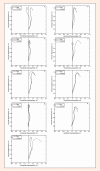A gender-based kinematic and kinetic analysis of the snatch lift in elite weightlifters in 69-kg category
- PMID: 24149133
- PMCID: PMC3737845
A gender-based kinematic and kinetic analysis of the snatch lift in elite weightlifters in 69-kg category
Abstract
The objective of this study was to compare the kinematic and kinetic differences in snatch performances of elite 69-kg men and women weightlifters, the only category common to both genders. The heaviest lifts performed by 9 men and 9 women weightlifters competing in 69-kg weight class in Group A in the 2010 World Weightlifting Championship were analyzed. The snatch lifts were recorded using 2 cameras (PAL). Points on the barbell and body were manually digitized by using Ariel Performance Analysis System. The results showed that maximal extension angle of the ankle and knee during the first pull, the knee angle at the end of the transition phase, and maximal extension angle of the knee in the second pull were significantly greater in men (p < 0.05). The angular velocity of the hip was significantly greater in men during the first pull (p < 0.05). During the second pull, women showed significantly greater maximal angular velocity at the hip and ankle joints (p < 0.05). Moreover, the maximal vertical linear velocity of the barbell was significantly greater in women (p < 0.05). The absolute mechanical work and power output in the first pull and power output in the second pull were significantly greater in men (p < 0.05). However, the relative mechanical work was significantly greater in women during the second pull (p < 0.05). The results revealed that in 69-kg weight class, women were less efficient than men in the first pull, which is strength oriented, whereas they were as efficient as men in the second pull, which is more power oriented. Key pointsWomen weightlifters should do assistant exercises to strengthen their ankle flexor and knee extensor muscles in order to increase their maximal strength in the first pull.Women weightlifters should be able to execute a deeper and faster knee flexion in the transition phase in order to obtain a greater explosive strength during the second pull.
Keywords: Biomechanics; body weight category; sex; weightlifting.
Figures
References
-
- Akkus H.(2011) Kinematic analysis of the snatch lift with elite female weightlifters during the 2010 World Weightlifting Championship. Journal of Strength and Conditioning Research, (In press). - PubMed
-
- Bartonietz K.E.(1996) Biomechanics of the snatch: Toward a higher training efficiency. National Strength & Conditioning Association Journal 18, 24-31
-
- Baumann W., Gross V., Quade K., Galbierz P., Schwirtz A.(1988) The snatch technique of World Class Weightlifters at the 1985 World Championships. International Journal of Sport Biomechanics 4, 68-89
-
- Burdett R.G.(1982)Biomechanics of the snatch technique of highly skilled and skilled weightlifters. RResearch Quarterly for Exercise and Sport 53, 193-197
-
- Campos J., Poletaev P., Cuesta A., Pablos C., Carratala V.(2006) Kinematical analysis of the snatch in elite weightlifters of different weight categories. Journal of Strength and Conditioning Research 20, 843-850 - PubMed
LinkOut - more resources
Full Text Sources


